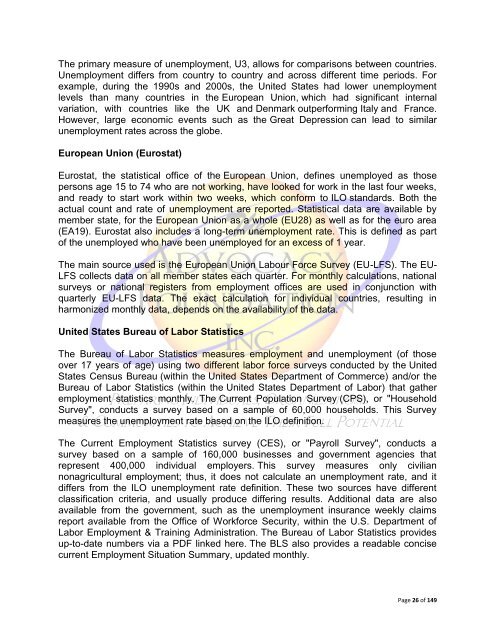Hidden Unemployment
Hidden Unemployment
Hidden Unemployment
Create successful ePaper yourself
Turn your PDF publications into a flip-book with our unique Google optimized e-Paper software.
The primary measure of unemployment, U3, allows for comparisons between countries.<br />
<strong>Unemployment</strong> differs from country to country and across different time periods. For<br />
example, during the 1990s and 2000s, the United States had lower unemployment<br />
levels than many countries in the European Union, which had significant internal<br />
variation, with countries like the UK and Denmark outperforming Italy and France.<br />
However, large economic events such as the Great Depression can lead to similar<br />
unemployment rates across the globe.<br />
European Union (Eurostat)<br />
Eurostat, the statistical office of the European Union, defines unemployed as those<br />
persons age 15 to 74 who are not working, have looked for work in the last four weeks,<br />
and ready to start work within two weeks, which conform to ILO standards. Both the<br />
actual count and rate of unemployment are reported. Statistical data are available by<br />
member state, for the European Union as a whole (EU28) as well as for the euro area<br />
(EA19). Eurostat also includes a long-term unemployment rate. This is defined as part<br />
of the unemployed who have been unemployed for an excess of 1 year.<br />
The main source used is the European Union Labour Force Survey (EU-LFS). The EU-<br />
LFS collects data on all member states each quarter. For monthly calculations, national<br />
surveys or national registers from employment offices are used in conjunction with<br />
quarterly EU-LFS data. The exact calculation for individual countries, resulting in<br />
harmonized monthly data, depends on the availability of the data.<br />
United States Bureau of Labor Statistics<br />
The Bureau of Labor Statistics measures employment and unemployment (of those<br />
over 17 years of age) using two different labor force surveys conducted by the United<br />
States Census Bureau (within the United States Department of Commerce) and/or the<br />
Bureau of Labor Statistics (within the United States Department of Labor) that gather<br />
employment statistics monthly. The Current Population Survey (CPS), or "Household<br />
Survey", conducts a survey based on a sample of 60,000 households. This Survey<br />
measures the unemployment rate based on the ILO definition.<br />
The Current Employment Statistics survey (CES), or "Payroll Survey", conducts a<br />
survey based on a sample of 160,000 businesses and government agencies that<br />
represent 400,000 individual employers. This survey measures only civilian<br />
nonagricultural employment; thus, it does not calculate an unemployment rate, and it<br />
differs from the ILO unemployment rate definition. These two sources have different<br />
classification criteria, and usually produce differing results. Additional data are also<br />
available from the government, such as the unemployment insurance weekly claims<br />
report available from the Office of Workforce Security, within the U.S. Department of<br />
Labor Employment & Training Administration. The Bureau of Labor Statistics provides<br />
up-to-date numbers via a PDF linked here. The BLS also provides a readable concise<br />
current Employment Situation Summary, updated monthly.<br />
Page 26 of 149

















